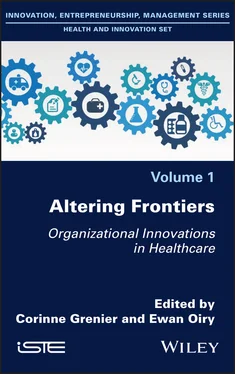At the same time, many testimonies have revealed daily the determination of all professionals and other stakeholders (charitable workers and citizens) to continue to practice their “profession for the other”. In many countries, everyone seemed to be rallying for the “common good”, based on a principle of solidarity in capitalist societies (Tirole 2016). What a lot of tinkering! In the sense that, in a do-it-yourself approach, the stakeholder knows the aims of his or her actions, but at the same time, he or she must identify or locate the resources to achieve them (Levis-Strauss 1962; Garud & Karnoe 2003).
These do-it-yourself projects, as varied as they are ingenious and surprising, are all based on the different facets of action that we have just mentioned, all of which are based on the identification of boundaries and the conditions under which they are crossed. However, they reveal, with renewed acuity, three ingredients for a sustainable transformation of the health system: the autonomy of the stakeholders, enabling them to invent solutions; the benevolence of the supervisory authorities, with a view to mobilize methodological and support resources to assist these professionals and organizations; and the need for a sense of control and evaluation to ensure the sustainability of this inventiveness.
Finally, it emerges from most of the chapters of the book that this crisis is also a call to put an end to a culture of “the fairest”. The crisis has revealed what can be called a slack of solidarity , when individuals, companies, merchants, etc., spontaneously offer their help and service. The term slack refers to the surplus (time, resources) which we do not know a priori what it can be used for, except when it has to be used! Schulman (1993) identifies two types of slack : that of resources (surplus not strictly engaged in current activities) and that of control relative to the degree of freedom in organizational activities (i.e. a set of actions that are not framed by formal modes of power, and supervision). It is thanks to these that the crisis is overcome as quickly as possible. May this lesson be kept in mind, not only because some people predict the multiplication and complexity of future crises, but more generally because it is an important condition for any innovative organization, when individuals have time, outside of protocolized and routine activities, to imagine how to renew themselves in a different way.
Agterberg, M., Van den Hooff, B., Huysman, M., Soekijad, M. (2010). Keeping the wheels turning: The dynamics of managing networks of practice. Journal of Management Studies , 47(1), 85–108.
Agterberg, M., Van den Hooff, B., Huysman, M. (2011). Cracking the core: How core members of electronic networks of practice contribute to organizational learning. Annual Meeting of the Academy of Management , San Antonio, Texas, 1–19.
Boiteau, K. and Baret, C. (2017). La conduite du changement en hôpital psychiatrique : le rôle des centres de traduction dans la valorisation des innovations lors d’un projet de promotion du bien-être au travail. Politiques et management public , 34(3–4), 231–246.
Bootz, J. (2015). Comment concilier auto-organisation et contrôle au sein des communautés de pratique pilotées ? Une scoping review. Management international , 19(3), 15–30.
Callon, M. (1986). Éléments pour une sociologie de la traduction : la domestication des coquilles Saint-Jacques et des marins-pêcheurs dans la baie de Saint-Brieuc. L’Année sociologique , 36(3), 169–208.
Carlile, P. (2004). Transferring, translating and transforming: An integrative framework for managing knowledge across boundaries. Organization Science , 15(5), 555–568.
Chesbrough, H. and Haas, W.A. (2006). Open innovation: A new paradigm for understanding industrial innovation. In Open Innovation: Researching a New Paradigm , Chesbrough, H., Vanhaverbeke, W., West, J. (eds). Oxford University Press, Oxford.
De Vaujany, F.X. (ed.) (2005). De la conception à l’usage : vers un management de l’appropriation des outils de gestion . EMS, Caen.
Garud, R. and Karnøe, P. (2003). Bricolage versus breakthrough: Distributed and embedded agency in technology entrepreneurship. Research Policy , 32(2), 277–300.
Grenier, C. and Denis, J.L. (2017). S’organiser pour innover : espaces d’innovation et transformation des organisations et du champ de l’intervention publique. Politiques et management public , 34(3–4), 191–206.
Grenier, C., Ibrahim, R., Duprat, L. (2020). Comment organiser un tiers-lieu éphémère pour favoriser l’émergence d’innovations institutionnelles ? Le cas d’un pôle d’opérateurs de services à domicile. Innovations , 66(1), 89–115.
Hargadon, A. (1997). Technology brokering and innovation in a product development firm. Administrative Science Quarterly , 42(4), 716–749.
Imbert, G. and Chauvet, V. (2012). De la capacité d’absorption à la capacité d’insémination. Revue française de gestion , 221, 111–127.
Lamont, M. and Molnár, V. (2002). The study of boundaries in the social sciences. Annual Review of Sociology , 28(1), 167–195.
Levi-Strauss, C. (1962). La pensée sauvage . Plon, Paris.
Mintzberg, H. (1993). Structure in Fives: Designing Effective Organizations . Prentice-Hall, Upper Saddle River.
Moore, M. and Hartley, J. (2008). Innovations in governance. Public Management Review , 10, 3–20.
Sahlin, K. and Wedlin, L. (2008). Circulating ideas: Imitation, translation and editing. In The SAGE Handbook of Organizational Institutionalism , Greenwood, R., Oliver, C., Suddaby, R., Sahlin, K. (eds). SAGE Publications, Thousand Oaks.
Schulman, P.R. (1993). The negotiated order of organizational reliability. Administration & Society , 25(3), 353–372.
Tirole, J. (2016). Économie du bien commun . PUF, Paris.
Todorova, G. and Durisin, B. (2007). Absorptive capacity: Valuing a reconceptualization. Academy of Management Review , 32(3), 774–786.
Wenger, E., McDermott, R., Snyder, W.M. (2002). Cultivating Communities of Practice . Harvard Business Publishing, Brighton.
Zietsma, C. and Lawrence, T.B. (2010). Institutional work in the transformation of an organizational field: The interplay of boundary work and practice work. Administrative Science Quarterly , 55(2), 189–221.
1 1EHPAD: Etablissement d’Hébergement pour Personnes Agées Dépendantes; retirement home.
2 2SAAD: service d’aide et d’accompagnement au domicile (social homecare service); SSIAD: service de soins infirmiers à domicile (home nursing service).
Introduction written by Corinne GRENIER and Ewan OIRY.
PART 1
Innovations as Seen by Stakeholders
Introduction to Part 1
Taking up the challenge of “altering frontiers” through organizational innovations raises the double question of the place of different individuals in this profound transformation.
Individuals are first and foremost at the heart of this transformation because they are the driving force behind it. They are singular individuals – the innovators – who develop new interdisciplinary practices, implement decompartmentalization and transform usual routines (Gherardi 2008). They transform their practices by experimenting in “innovative spaces” typically outside the organization, sometimes protected from the rules that usually govern it (Bucher & Langley 2016). They are sometimes tired of the multiple social norms to which they cross in order to innovate (Alter 2011). However, they are clearly, for many, the heart and driving force of the organizational innovation process that enables decompartmentalization.
Читать дальше










